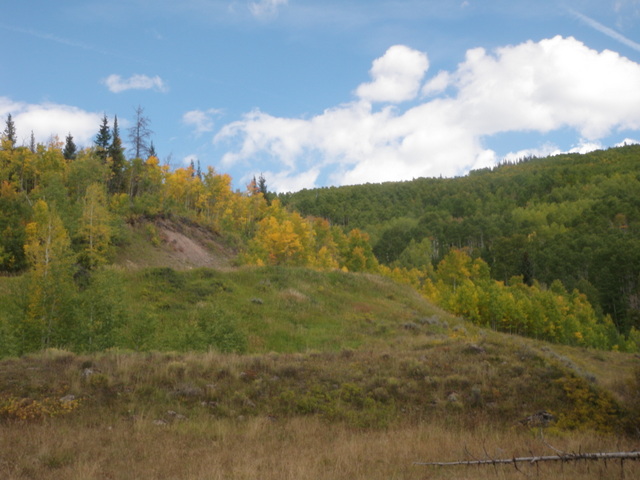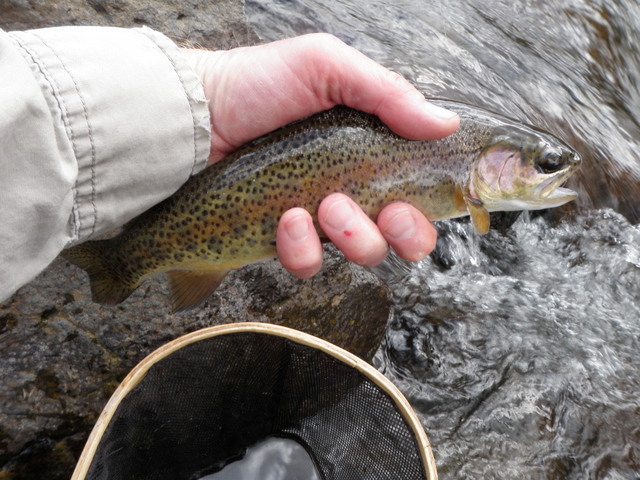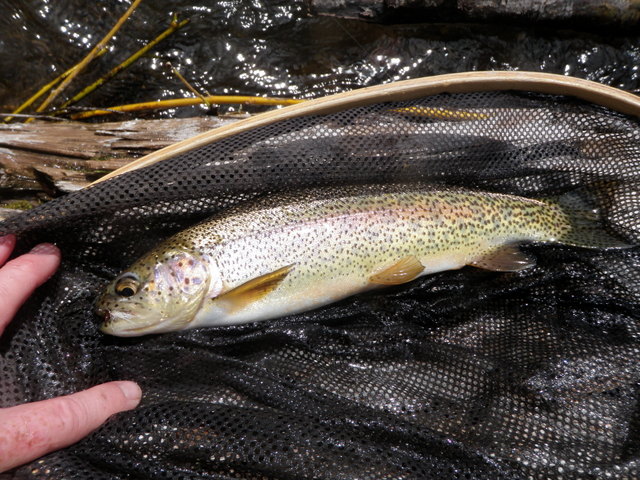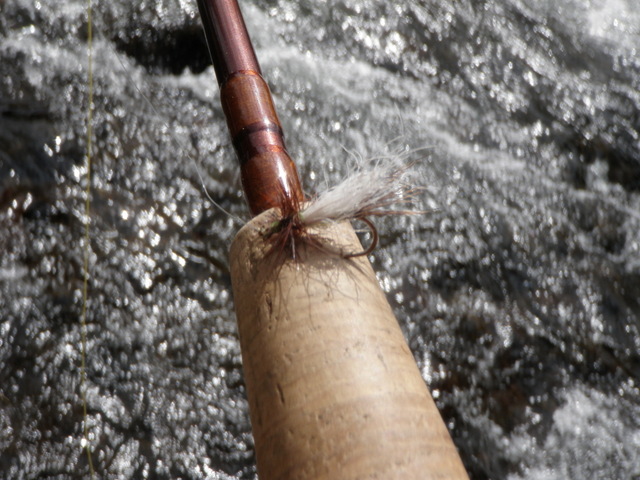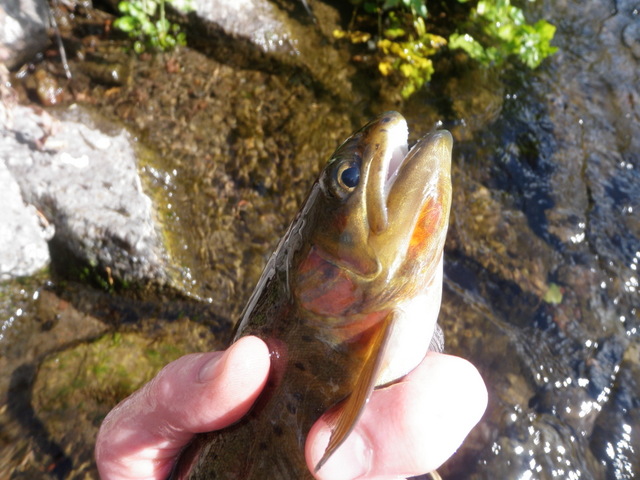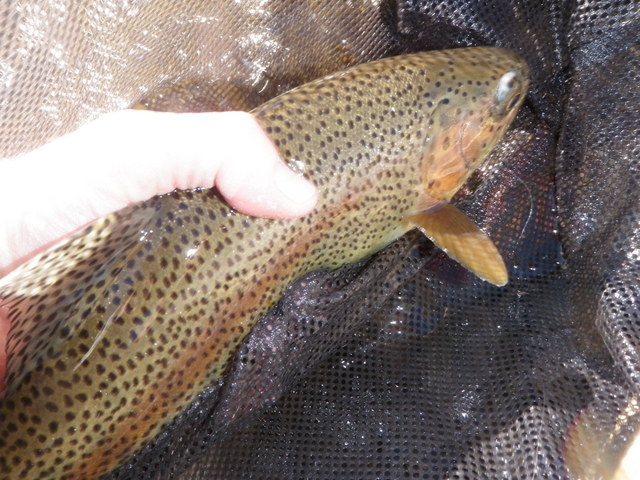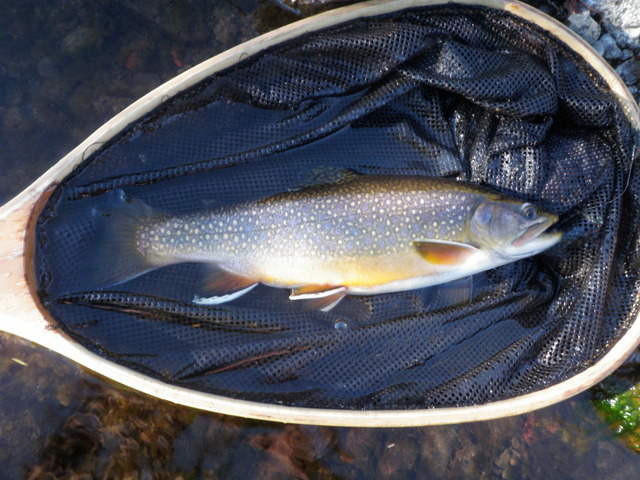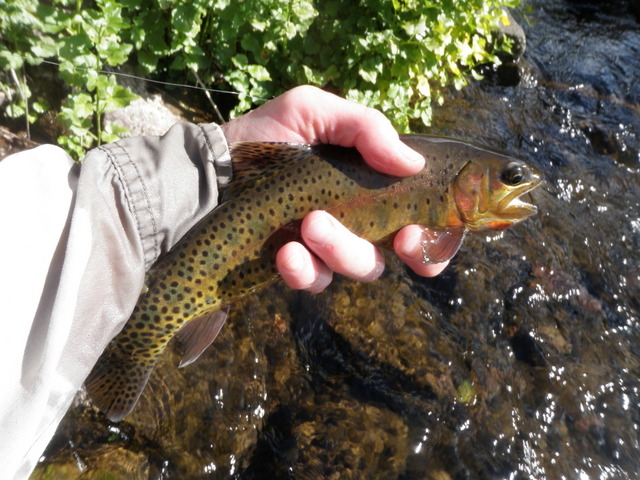Time: 12:30PM – 6:00PM
Location: Himes Peak Campground and upstream
Fish Landed: 40
North Fork of White River 09/16/2014 Photo Album
I kept my eye on the weather after being thwarted in my efforts to visit the Flattops Wilderness the previous week. I was in a lull at work, and a fishing trip during the week of September 16 – 19 worked nicely with my schedule. When I noticed a weather forecast for a series of days in the 80’s in Denver, I made the decision to reschedule my Flattops trip. The forecast for Meeker, CO on the western rim of the Flattops was similar to Denver, so that clinched it.
The drive to the North Fork Campground from Denver is four hours, and I wanted to enjoy at least a half day of fishing on Tuesday, so I had nearly everything packed and ready on Monday night. This enabled me to depart Denver by 7AM, and I arrived at the campground by 11:40AM. I quickly paid for the campsite and gobbled my lunch and headed to the Himes Peak Campground on the way to Trappers Lake to begin my fishing adventure.
Since I lost my Simms fly box on the Frying Pan River, I purchased a replacement along with ten stimulators. I rotated this box to my front pack and then shifted the Pennsylvania box to my zippered bib pocket in my waders. I assembled my Orvis Access rod (which I would come to regret) and hiked down the trail from the parking lot toward the stream. After a short distance I cut to the left and then skidded down a steep bank to the stream. The stream remained high from the heavy rain the previous week, and a steep gradient made fishing difficult. In addition numerous deadfalls spanned the stream as a result of a wildfire several years ago, and this added significantly to the casting and wading difficulty.
Initially I used a gray pool toy and beadhead hares ear dropper, and I did not have any problem hooking fish. Unfortunately I did have difficulty landing fish, as the first five hook ups resulted in long distance releases. This was quite frustrating particularly as several of the fish felt quite heavy in proportion to the small high mountain river. I decided to change tactics and removed the dry/dropper and switched to a purchased stimulator with a light green body. With this fly on my line, I finally connected with and landed four fish by 1:30.
I continued upstream and covered a ton of water and built my fish count to nine, but I lost the stimulator along the way and replaced it with a lime green trude, and this productive fly accounted for three or four of the first nine fish. At 2:30 I decided to try a Chernobyl ant with a beadhead pheasant tail as a short dropper as I was weary of continually drying the trude. I knew that a long dropper was asking for trouble given all the logs and brush, so I kept the dropper length at 18 inches. After making this change, as I was wading along the edge of the stream, I stepped on a slanted wet slimy rock and my right foot shot sideways into the stream. I reacted instinctively by reaching out my left hand to catch my fall, but this hand also held my Orvis Access four weight rod. I dropped the rod as my hand went toward the ground, but it was two late, and after picking myself up and gathering my senses, I realized that I snapped the rod in the middle of the second piece after the butt section. I’m not sure if the tip hit the ground and snapped the rod or if the impact of dropping the rod did the damage, but the cause was irrelevant, and I now had a broken rod.
I uttered some curse words and grieved for a bit, but then gathered the pieces and made the 15 minute hike back to the car where I had two back up rods. I selected my Sage four weight and assembled it and hiked back to the scene of my fall. I was feeling pretty low at this point near the start of my four day fishing adventure. The catch rate was slower than I expected, the wading was quite challenging, and I broke my rod. In addition I had to hike all the way back to the car through a mucky beaver pond, obtain another rod, and hike the same distance back to the river.
Since I was starting over with a new rod, I decided to try another purchased crystal stimulator, and I selected one with a gray body. This choice proved to be a winner, and I landed a bunch of fish and took my tally to the mid-20’s until I lost a second purchased stimulator. I had another three days of fishing ahead of me, and I’d already lost 20% of my purchased stimulator inventory. I had some royal stimulators that I tied several years ago, so I decided to try one in an effort to preserve my purchased flies. The royal model worked reasonably well, and I added another three or four fish to my count before I began to see a decent number of blue winged olives.
I knew an exact match such as a CDC olive comparadun would be nearly impossible to see in the rushing mountain stream, so I tied the Chernobyl ant back on my line and added a soft hackle emerger as a dropper. I hoped that the fish would see the soft hackle emerger as an emerging blue winged olive, and the Chernobyl ant with the bright neon yellow foam indicator would allow me to spot takes. This tactic did not work very well, and I can only assume that the tiny size 20 emerger was too difficult for the fish to see in the swirling currents. I clipped off the soft hackle emerger and replaced it with a salvation nymph, and this combination was on fire for the last hour of the day.
As the shadows lengthened I approached a broken beaver dam and surveyed the water. It was a beautiful set up as the breached dam enabled the current to continue running through the center, but nice slower moving pools spanned out from the center to the banks on both sides where the stick dam remained. I began drifting my dry/dropper combination along the seam of the main current first and then gradually lengthened my casts to methodically cover the entire width of the pool. On nearly every cast I hooked a fish, and eventually landed at least seven or eight from this one location. It was a blast, and these fish were chunky hard fighting rainbow trout that streaked in every direction around the pool. The most amazing fact was that the disturbance of a hooked fish did not seem to impact the desire of neighboring fish to inhale my salvation nymph on subsequent casts.
I decided to quit at 6PM despite the fact that the fishing remained quite productive because I had a tough hike along the fence line back to the car. I ended farther from the parking lot than I’d ever ventured, and I really wasn’t sure about my exit route. I ended up fighting through some deadfalls and walking perpendicular to the stream until I encountered the fence. The fence was very taut, and I could not determine a way through or around it, so I followed it back to the road that led to Himes Peak.
What an afternoon! I landed 40 trout with a ratio of 80% rainbows and 20% brook trout. The rainbows were feisty chunky hard fighting wild fish mostly in the 12-13 inch range with a few 14 inch fish to make things interesting. I probably could have tallied 70 fish had I landed every trout that I hooked. I attribute the high escape ratio to the narrow stream and the multitude of snags and obstacles that made maintaining constant side pressure a significant challenge.
I accomplished all this in half a day of fishing with thirty minutes lost to a round trip to the car to get another fly rod. What an amazing day! It was just too bad I broke my rod on the first day.

